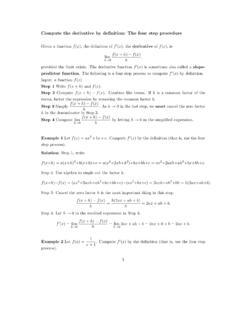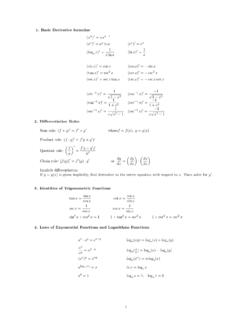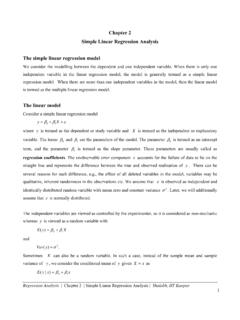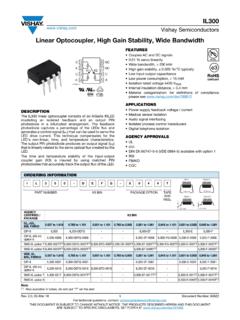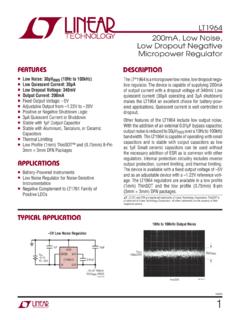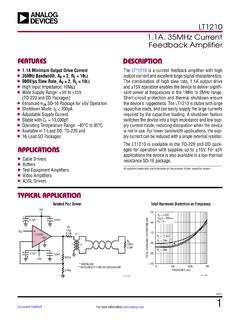Transcription of CHAPTER 6 Power Series Solutions to Second Order Linear …
1 A Series OF CLASS NOTES FOR 2005-2006 TO INTRODUCE Linear AND. NONLINEAR PROBLEMS TO ENGINEERS, SCIENTISTS, AND APPLIED. MATHEMATICIANS. DE CLASS NOTES 2. A COLLECTION OF HANDOUTS ON SCALAR. Linear ORDINARY DIFFERENTIAL EQUATIONS (ODE"s). CHAPTER 6. Power Series Solutions to Second Order Linear ODE's 1. Review of Linear Theory and Motivation for Using Power Series 2. Functions Defined by Power Series 3. The Interval of Convergence of a Power Series 4. Taylor and MaClaurin Series 5. Power Series Solution of Second Order Linear ODE's Ch. 6 Pg. 1. Handout No. 1 REVIEW OF Linear THEORY Professor Moseley AND MOTIVATION FOR USING Power Series . Recall that for the remainder of the course that we will not attempt to cover all of the material in the text on a particular topic.
2 Rather you will get only a taste of the topic so that you will have a good start when you see it again in another course. REVIEW OF Linear THEORY FOR ANALYTIC FUNCTIONS. Recall the general Second Order Linear differential operator L defined by L[y] = yO + p(x)y + q(x)y (1). where p, q 0 A(I) and I = (a,b) is the interval of validity. We have considered the homogeneous equation L[y] =0: ( L[y] = ) y" + p(x) y' + q(x) y = 0 x 0 I (2). and the nonhomogeneous equation L[y] = g 0 A(I): ( L[y] = ) y" + p(x) y' + q(x) y = g(x) x 0 I. (3). THEOREM #1. Let S = { y1, y2 } be a set of linearly independent Solutions to the homogeneous equation (2). Now assume that we can find a ( one) particular solution yp(x) to the nonhomogeneous equation (2).
3 Then y(x) = yp(x) + yc(x) where yc(x) is the general solution of the associated homogeneous equation (also called the complementary equation) (2). That is, the general solution of (3) is given by: y(x) = yp(x) + c1 y1(x) + c2 y2(x). (4). This theorem reduces the problem of finding the general solution of the nonhomogeneous equation (3) to finding the three functions yp(x), y1(x), and y2(x). If the homogeneous equation has constant coefficients, we have developed a technique to for finding y1 and y2. For a large number of forcing functions g(x) in A(I), we can find yp by using either the method of undetermined coefficients or variation of parameters. However, if this is not the case, we do not have a technique for solution (unless for example we have an equation in which y is missing or x is missing).
4 We wish a technique for the case of variable coefficients, that is when p and q are not constants. MOTIVATION FOR USING Power Series . We wish to develop a more general technique which works for the case when the Solutions of (2) and (3) are analytic functions. Recall that a function f 0 C4 (I) = {f:I6 R: f(n) is continuous n 0 N} is analytic on I = (a,b) if for all x0 0 I, there exists an open interval containing x0 where f(x) equals its Taylor Series . We first review Power Series and how a function ( a real valued function of a real variable) can be defined by a Power Series . We then review how a function in C4(I) defines a Power Series at a point x0 and hence how to compute Taylor Series of an analytic function.
5 Ch. 6 Pg. 2. Handout No. 2 FUNCTIONS DEFINED BY Power Series Professor Moseley Let f(x) be a real (or complex) valued function of a real (or complex) variable. Recall how to find a Power Series expansion (or representation) of this function by finding its Taylor Series (or its Maclaurin Series if the Series is about zero). On the other hand, if we are given a Power Series with coefficients an, n = 0, 1, 2, 3, .. , then this Power Series defines an analytic function y = f(x) = = a0 + a1 x + a2 x2 + a3 x3 + .. + an xn + .. on its (open) interval (or circle) of convergence. We may think of the sequence as the name of the function f since, given a value of x, we can compute a value for y = f(x), provided we can "sum the Series ".
6 Practically, this may mean that we use a computer to obtain y = fA(x) = , where the remainder RN = is small. The (open) domain of the function is the (open) interval of convergence of the Power Series . We review the following skills which you mastered in a previous course: 1. How to determine the interval of convergence of a Power Series using the Ratio test. 2. How to compute the (coefficients in the) Power Series for a given function ( how do we compute the Taylor or Maclaurin Series for a given function). A third skill which you may have previously mastered: 3. How to change the index when using sigma notation. will be covered when we learn how to use Power Series to solve a Second Order Linear differential equation with (constant or) variable coefficients.
7 Ch. 6 Pg. 3. Handout # 3 THE INTERVAL OF CONVERGENCE Professor Moseley OF A Power Series . Consider the Power Series y= = a0 + a1 x + a2 x2 + a3 x3 + .. + an xn + .. (1). Let Rn =df = * x* (2). and L =df Rn = ( lim ) * x* . (3). THEOREM (Ratio Test). Then the Power Series converges if L < 1. It diverges if L > 1. If L = 1, the test is inconclusive. Thus the Power Series converges on the open interval where L < 1, diverges outside the closed interval where L # 1, and we must use some other test for the endpoints. However, since we wish to solve ODE's, we wish the domain ( the interval of validity) of our Solutions to be open intervals. Hence we are not particularly interested in the end points and will not review the tests needed to check for convergence at the endpoints ( , alternating Series test).
8 Finding the open interval L < 1 where the Series converges ( the open interval of convergence) is sufficient. EXAMPLE #1. Find the open interval of convergence for the Power Series : y= , where an = (-1)n+1 xn/2n ; that is, for the Power Series y =. Solution. Let Rn = = = * x* . Note that although Rn is usually a function of n, for this example, it is not. This makes computing the limit easy. Let L = Rn = ( ) * x* = * x* = * x*. Ch. 6 Pg. 4. Hence L < 1 Y * x* < 1 Y * x* < 2 Y x 0 I = (-2, 2). The radius of convergence, usually denoted by D, is half of the length of the interval I. The reason that it is referred to as the radius of convergence is that a Power Series can be considered as a complex valued function of a complex variable.
9 In this context, the Ratio Test applies to the Series : f(z) = . (4). in which case L < 1 implies convergence within a circle of radius D about the origin, L > 1. implies divergence outside this circle, and the test is inconclusive on the circle where L = 1. Ch. 6 Pg. 5. Handout # 4 TAYLOR AND MCLAURIN Series Professor Moseley Recall from calculus THEOREM (Taylor Series ). For any function f(x) that is analytic at the point x0, we have f(x) =. = f(x0) + [fN(x0)] ( x - x0 ) + ( x - x0 )2 + AAA+ (x - x0 )n + @ @ @ . inside some interval (circle if x is replaced by the complex variable z) centered at x0. EXAMPLE #1. Find the Maclaurin Series for f(x) = ex Solution.
10 Find the Maclaurin Series means find the Taylor Series for x0 = 0. f(x) = ex f(0) = e0 = 1. f'(x) = ex f'(0) = e0 = 1. f"(x) = ex f"(0) = e0 = 1. @ @ @ f(n)(x) = ex f(n)(0) = e0 = 1. Hence f(x) = = f(0) + [fN(0)] x + x2 + AAA+ xn + @ @ =1 + x + x2 + x3 + @ @ @ + xn + @ @ @ . =. EXAMPLE #2. Find the Maclaurin Series for f(x) = sin(x). Solution. Find the Maclaurin Series means find the Taylor Series for x0 = 0. Ch. 6 Pg. 6. n k f(n)(x) f(n)(0). 0 0 f(x) = sin(x) f(0) = sin(0) = 0. 1 0 f'(x) = cos(x) f'(0) = cos(0) = 1. 2 0 f"(x) = -sin(x) f"(0) = -sin(0) = 0. 3 0 f"'(x) = -cos(x) f"'(0) = -cos(0) = -1. 4 1 f(4)(x) = sin(x) f(4)(0) = sin(0) = 0. @ @ @ @ @ @ @ @ @ We substitute into Taylor's formula and look for a pattern: f(x) = = f(0) + [fN(0)] x + x2 + AAA+ xn + @ @ =0 + x + 0 !
